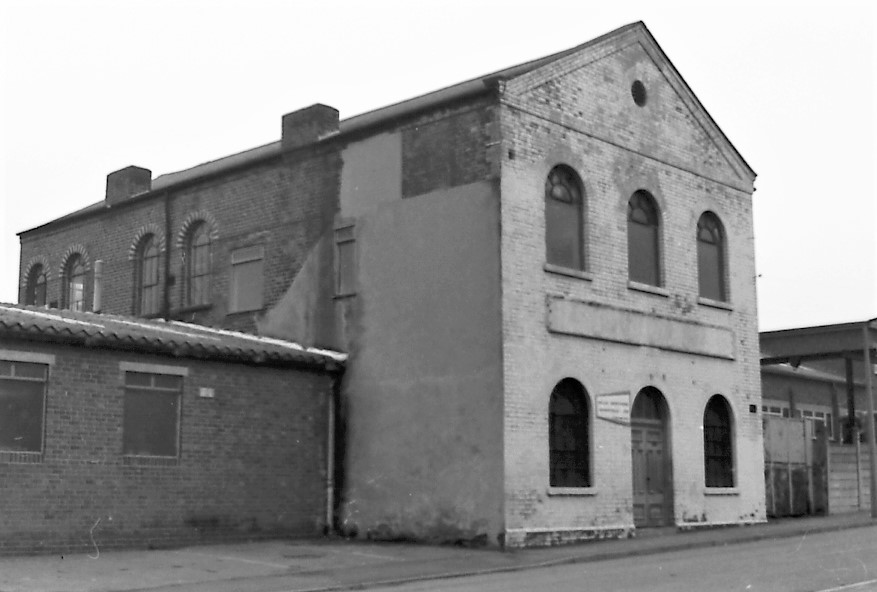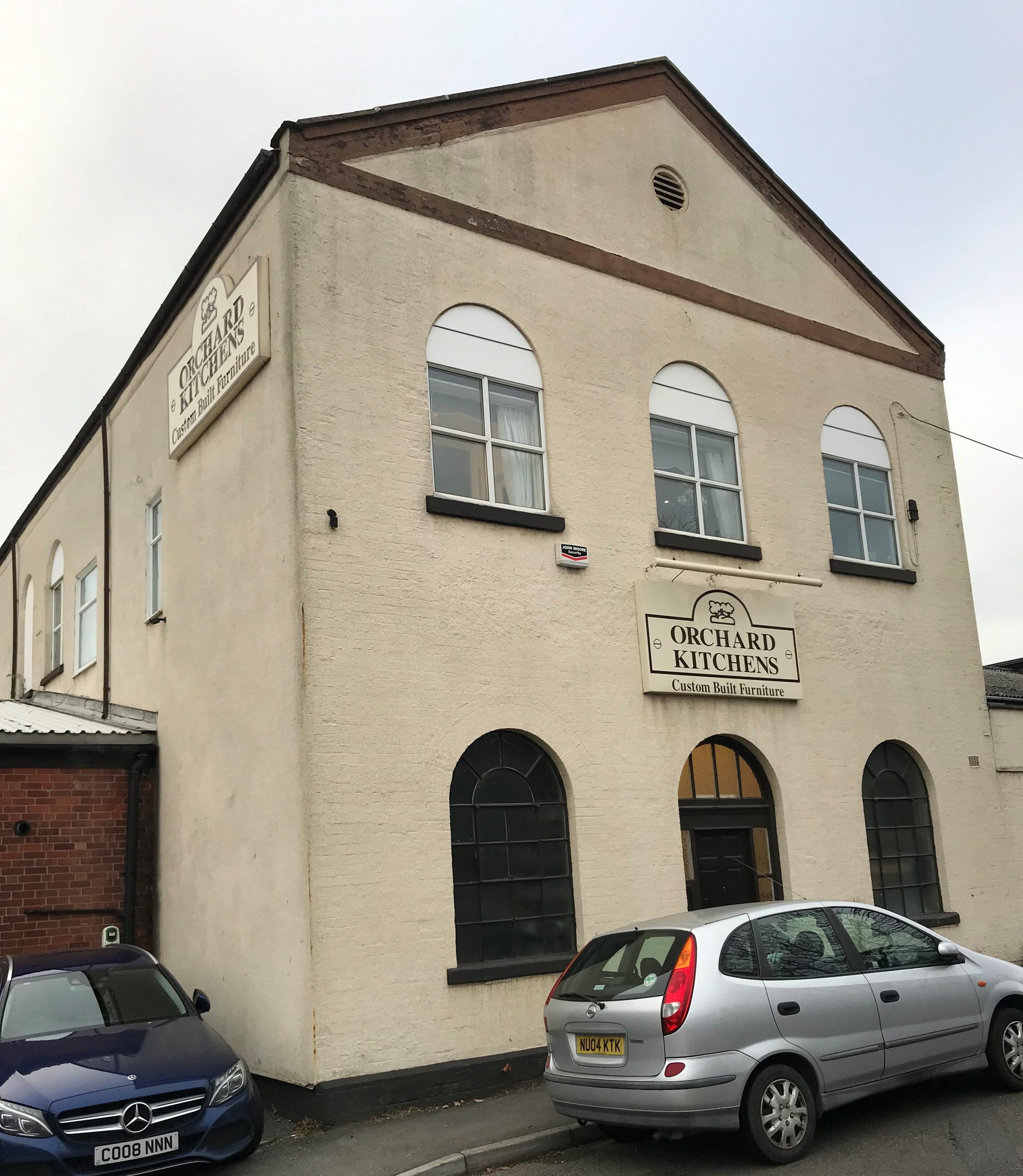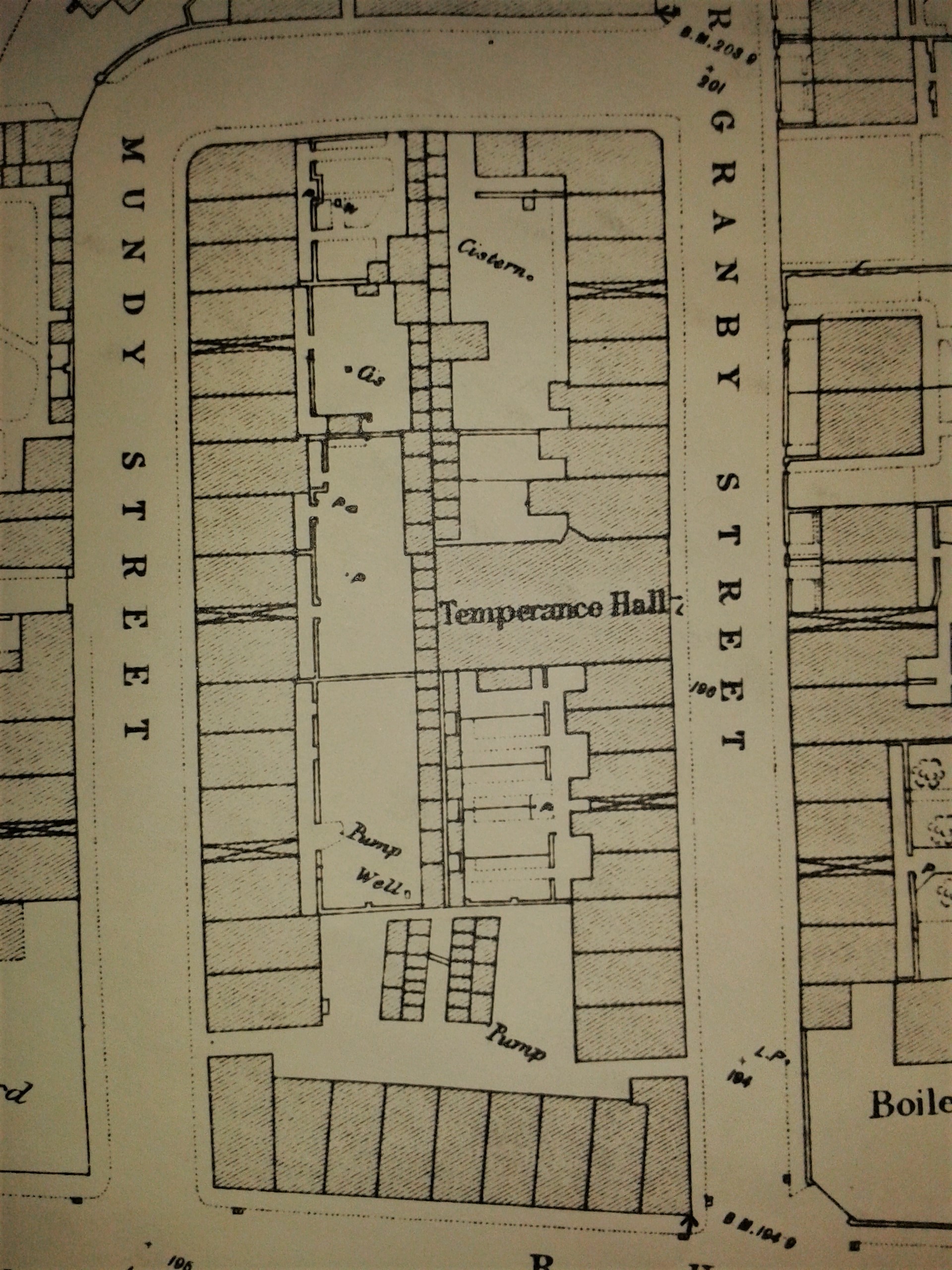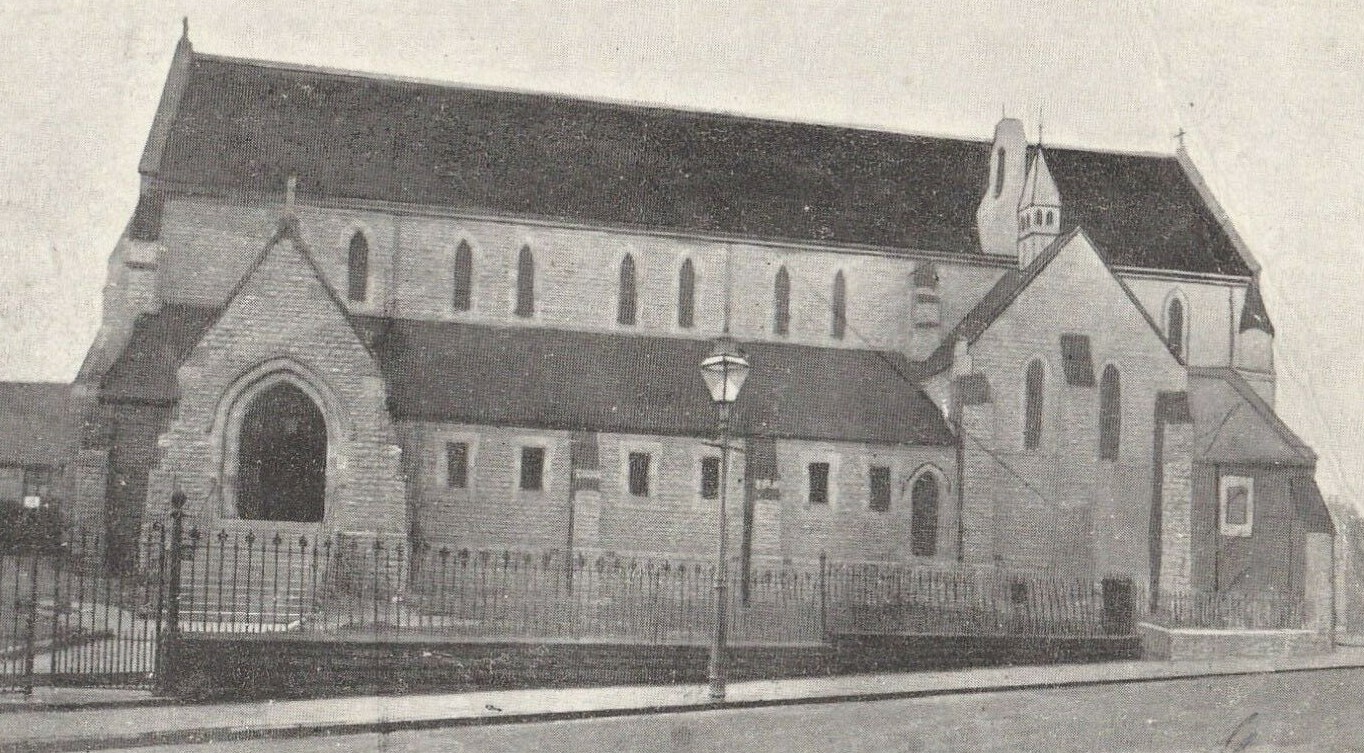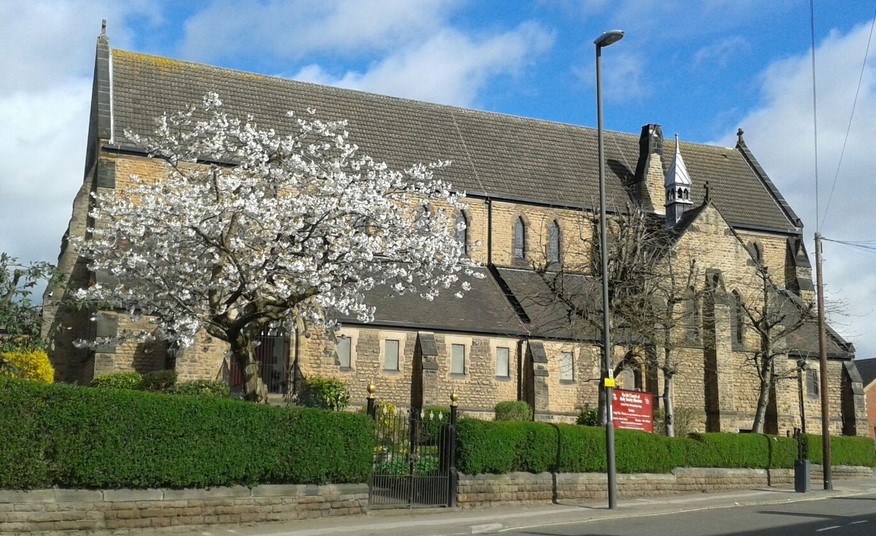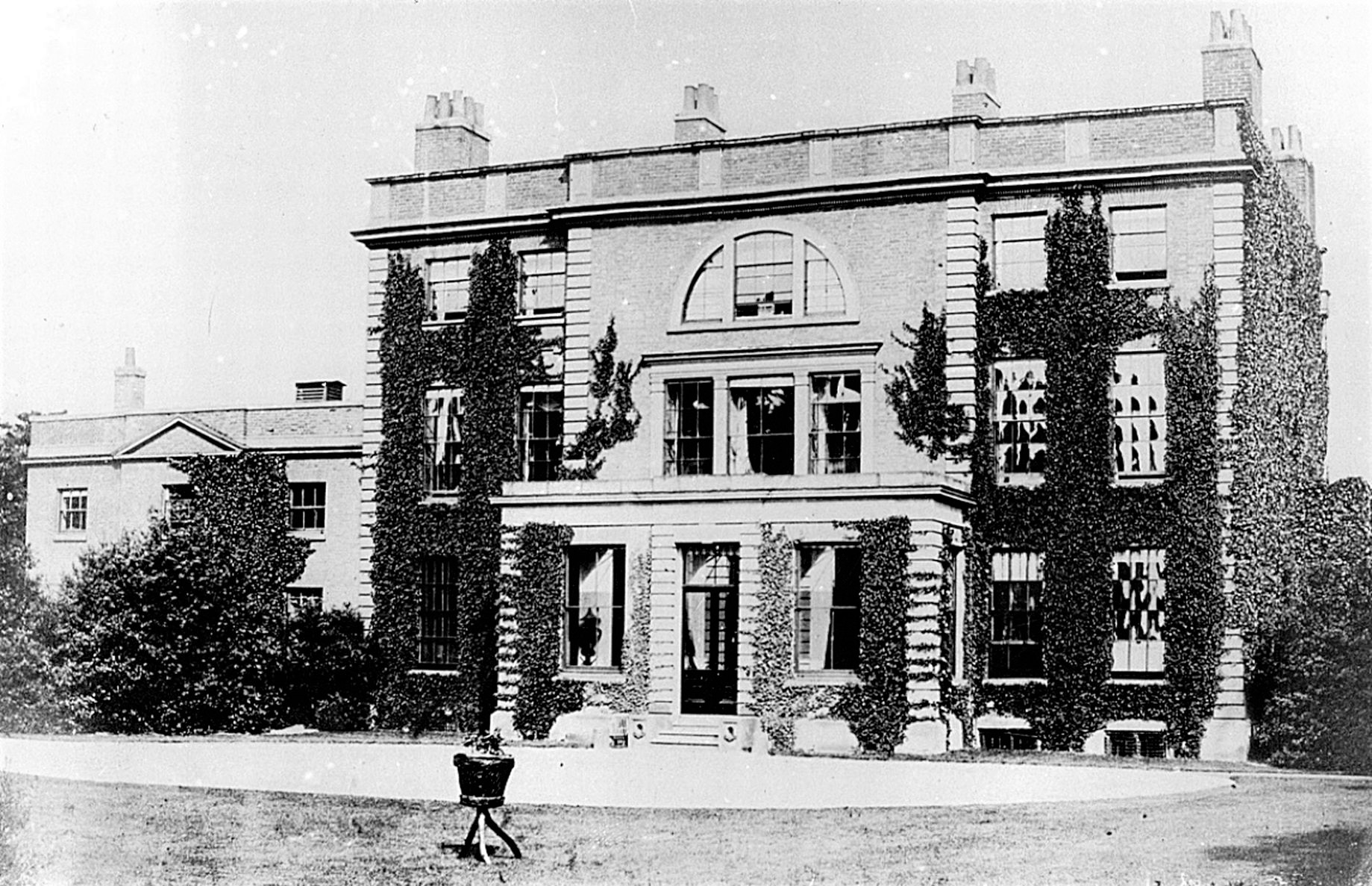Ilkeston’s workhouse had links with the Holy Trinity Mission.
The workhouse 1790-1875
An article in the Pioneer of 1889 charting the history of the Holy Trinity Parish stated that in 1860 the Rev. George Searl Ebsworth had founded a Sunday School in an upper clubroom of the Jolly Boatman Inn, which stood behind the later Victoria Hotel on Awsworth Road.
Shortly after, the vicar moved to the former workhouse rooms built in 1790 on Heanor Road (then called Workhouse Hill) to use them as a meeting house, a ‘Mission on the Common’.
It met with success and Sunday evening services were well attended.
“It was in this old humble-looking building, with its windows of diamond-shaped panes and its whitewashed walls, with here and there a Scriptural text by way of adornment, that the foundation was laid for the far more noble-looking House of God which has reared its head in the immediate vicinity”.
The last vestiges of the workhouse were swept away during the construction of the Great Northern Railway in 1875-1878. On August 8th 1875 the last two sermons at the Heanor Road Mission were preached — one in the afternoon by the Vicar of Christ Church, Cotmanhay, and the evening one by the Curate of Cossall. The Mission then moved into the newly-built Holy Trinity Church School in Factory Lane.
————————————————————————————————————————————————————-
The Temperance hall 1877-1889
Still under the ministerial supervision of the curates of St. Mary’s Church, this school was used for services until the Mission moved to the new Temperance Hall in Lower Granby Street in April 1878. This Hall (below) had been erected by lacemaker William Hewitt at a cost of about £1500 and presented to the Temperance Society, the Secretary of which was joiner Joseph Scattergood of Market Street.
It had opened in August 1877, after an afternoon parade from the Market Place to the hall by about 100 members of the temperance lodges, led by the Nottingham Sax-Tuba Band.
Here’s the former Temperance Hall in the recent past (Jim Beardsley collection)…..
… and here it is today (2021) in Lower Granby Street.
On its ground floor were coffee and reading rooms, and a large lodge room, “with a dwelling-house attached, so that the person providing the refreshments will be able to reside upon the premises”. (IP) On the upper floor was a spacious hall for public meetings.
So, in April 1878, after a short service of dedication, the Hall became a place of worship, almost immediately celebrating a Holy Communion and three festivals, attended by a choir robed in cassocks and surplices. The heightened ‘ritualistic’ nature of these services seems to have evoked strong comments, both from those who attended them and those who didn’t ! A ‘sacristy’ was set up at one end of the Hall while a large wooden cross was fixed to the reredos, either side of which were vases of flowers and wax candles … and the congregation stood. “The building is not even consecrated or licensed for the purpose of conducting Divine service therein”. (IP Apr 25th 1878).
Again this move to another meeting place did not diminish the enthusiasm of the locals.
Attracting a large congregation, “the services carried out in the temporary Mission Room… were frequent and hearty, and the ritual, though imposing, was not extreme’. Despite this success there was still a desire among the populace of the district for a more permanent home.
The Temperance Hall and surrounding streets in 1879/80
P.S. In January 1889 this hall was up for sale by auction. At that time it was described as having a large upstairs hall 58ft by 30ft, a smaller hall 30ft by 30ft, two cloakrooms, and heated throughout by hot water. It was occupied as the Salvation Army barracks, and had two dwelling houses attached to it — numbers 11 and 12 Lower Granby Street. This same collection of premises was also put up for auction at the end of January 1896 and then again in July 1897.
In May 1893 a new Temperance Hall and reading room was opened in Bath Street, close to the Wesleyan Chapel there. Made of wood it had cost £100 with an estimated £100 to be spent. It had a hall, 20 yards long and about six yards wide, with a small room beneath for the sale of temperance literature. Joseph Scattergood and his second wife Maria had been the motivating forces behind its establishment.
At that time there were 49 public houses in Ilkeston.
June 1896 … time moves on — and so does the Temperance Hall !! Because of the development of the new Wesleyan ‘Temple’ in Bath Street, the Temperance movement had lost its site there. Their hall had been forced to move into Wilton Place, to the rear of the Brunswick Hotel and this relocation spurred a new application for a music licence for the new premises. No dancing of course. Application granted.
Although the Movement was in serious debt the site was purchased and a new wooden building was constructed. It was of single storey, 64 feet long by 17 feet, and came courtesy of the efforts of Joseph, Charles Woolliscroft, Joseph Briggs and other supporters. The reopening service took place on September 16th.
————————————————————————————————————————————————————-
A new church needed ? Welcome Holy Trinity
Holy Trinity Church (the second photo is from achurchnearyou.com)
On October 9th 1879 the Pioneer published the following Memorial, written by parishioners of the Holy Trinity District, setting out in detail the successful history of the Mission there and their desire for a new Church and Parsonage to be built in the area.
MEMORIAL.
Copy of Working Men’s Memorial to be forwarded to the Right Rev. the Lord Bishop of Lichfield, from those connected with the Holy Trinity Mission, Ilkeston:
MY LORD, MAY IT PLEASE YOUR LORDSHIP,
We, the undersigned, working men, communicants of the Temporary Church of the Holy Trinity, Ilkeston, beg most respectfully to lay before your Lordship the following particulars relative to the above Mission, and in doing so would humbly desire your Lordship to give the matter your most serious consideration.
The Mission was commenced by the Rev. G.S. Ebsworth, then Vicar of Ilkeston, in 1859. The years of its infancy are thus described by the Rev. Gentleman himself: —
“I had been for several years endeavouring to obtain a room for school and service near Barker’s Bridge*, in order to be an introduction to the Church. I proposed to build on the spot of ground where Bailey’s factory** was afterwards built: but I was unable to obtain any place till July, 1859, when I was able to hire a room at Marson’s,° which was used by a pipe maker during the week. This continued till July, 1860, when the room could no longer be spared.
At the death of one of the inmates of the old workhouse yard°°, I was granted a small room, and at the death of a second inmate another room was added.
My curates, Mr. Jowitt and Mr. Leggatt sometimes did the duty at Marson’s, but as the congregation did not increase in consequence of the inconvenient room and position, they requested me not to require them to attend, and eventually I did all the duty there, and Mr. Jowitt took the Evening Service at the Parish Church.
After the opening of the room at the workhouse yard, we had service on Friday evenings and Sunday evenings, and the congregations increased to such a degree that we sometimes preached at the doorway, so that those inside and those in the yard might hear the better.
Mr. Jowitt left in December, 1862, and in a few weeks after my other curate became too ill for duty, so that having three services on Sunday and one on Wednesday evening at the Parish Church, I was compelled to have only a Friday evening service at the Mission Room, until Trinity Sunday, 1863, when I was able to obtain assistance. But I left after the beginning of August”.
The Rev. J. Horsburgh, Mr. Ebsworth’s successor to the vicarage of Ilkeston, efficiently carried on the work of the Mission during the ten years he laboured in the parish, and thus speaks of the results of his exertions: —
“I have no hesitation in saying that the character of the whole north side of the town was altered by our Mission Services. When I left there was an excellent room, where there was a crowded attendance on Sundays, and twenty or thirty on a Wednesday evening. Besides how can I forget the Sunday School we established there; I think there were 100 children. I must say this, though I take little credit for the great work done at the Mission Room, for it was owing to the labour of my curates, and the kind help that I received from you all, that, as I look back on my ten year’s work at Ilkeston, I cannot help feeling that the work at the north end of the town showed more fruit than I elsewhere was permitted to see when I resigned”.
The Rev. J.F.N. Eyre, the present vicar, succeeded Mr. Horsburgh in his ministrations at Ilkeston, and promised your Lordship’s lamented predecessor to vigorously carry on the work in this part of the town.
Services were successfully continued at the Mission Room by his curates, and after much exertion on the part of those connected with the movement, and liberal aid from outside friends, suitable schools, capable of accommodating 300 children, were erected on land kindly given by His Grace the Duke of Rutland, who also generously promised another site, together with £500 towards the erection of a church.
Upon the completion of the schools, the largest room was brought into requisition for the Sunday and Weekday services, under the ministrations of the Rev. T.A. Taggart, curate at the Parish Church, who laboured incessantly, and continued to draw together an increasing congregation from amongst the working classes of the district.
About this time a Memorial was forwarded to the late Bishop from the congregation, praying for his Lordship to assist them in the formation of a New District and the erection of a Church and Parsonage. To this a prompt reply was received, favourable to the scheme, and instructions given for the Memorialists to prepare a map of that portion of the parish, showing the proposed New District, the spot where the church was to be erected, and the distance from the Parish Church, to lay before the Ecclesiastical Commissioners. This was at once procured and forwarded to that body for their approval. The promoters of the movement now looked upon the erection of a Church as a certainty, plans were prepared, a Building Committee formed, with the Vicar of Ilkeston as Chairman, and liberal subscriptions promised.
At this point matters remained when the Rev. T. A. Taggart resigned his curacy, and the Rev. F. L. Ware, our present priest, was appointed to the Mission, upon the distinct understanding that the proposed scheme would be at once proceeded with. Even the School-room was now found to be altogether inadequate to accommodate the increasing congregation, consequently the large Room at the Temperance Hall was rented and fitted up as a temporary Church, as your Lordship will see from the accompanying photograph. The Rev. F. L. Ware immediately used every exertion to proceed at once with the proposed scheme for the erection of the Church and Parsonage, but owing to a stagnation in trade, and other matters over which we have no control, the project was for a time abandoned, in the hope that with renewed prosperity in trade the matter would be taken up with increased vigour.
In the course of a few months however, the temporary Church proved even too small for our requirements, numbers having frequently to be turned away for want of accommodation. It was now considered advisable to revive the former project, and a meeting of the congregation was held in the school-room on the 16th September, 1878, to consider what steps should be taken to forward the scheme, when it was unanimously resolved that two Memorials should be prepared (one for presentation to your Lordship, the other to His Grace the Duke of Rutland), praying that the formation of the New District and the erection of Church and Parsonage be at once proceeded with. The Memorial, accompanied by over 1000 signatures, together with the copy of the letter from the late Bishop, was duly forwarded to your Lordship, on the 17th of October. On the 22nd October, a reply was forwarded to us, from your Lordship, and asking whether a map as recommended by the late Bishop had been prepared, promising when such had been forwarded for your inspection to lay the matter before the Commissioners. We then informed your Lordship that such steps as recommended had been taken, and that the necessary map had been procured and forwarded to the Commissioners by the Rev. T. A. Taggatt (sic) during his ministry here. To this your Lordship replied on December 2nd, that the map had been found, but that the Commissioners required a certificate from a competent Mining Engineer as to the state of the land upon which the Church was proposed to be erected.
At this stage matters have remained up to the present time. Our Memorial to His Grace the Duke of Rutland, forwarded by us last October, was favourably received, His Grace adhering to his former kind promise of a site together with a liberal subscription. Owing, however, to the progress of mining operations underneath the whole of the land belonging to His Grace in this part of the parish, no site at that time could be found available for the purpose. But we believe this difficulty could now be obviated.
We now learn that the Rev. F. L. Ware is about to leave us, and that in all probability the Mission will then be closed. That such a calamity may be avoided is our most earnest prayer, and must be our apology for again troubling your Lordship in this matter. We cannot speak too highly of the labours of our present Priest, who by his good example and teaching has endeared himself to all of us. Your Lordship will be best able to form an estimate of his labours here by the following extract from a report published by him last Easter: —
“During the year from Easter, 1878, to Easter, 1879, there have been held 550 services. The Holy Eucharist has been offered 128 times, and there have been 615 Communions made. The number of Communicants at Easter last year was 49; at Christmas, 35; and this Easter, 55. There have been 54 baptisms, of which 11 were private, and 2 adult”
From this your Lordship cannot fail to see the steady increase of the Mission, and the attempts that from time to time have been made to provide for the spiritual wants of the large population within the proposed new district, at present numbering about 5000 souls, almost exclusively, of the labouring class who, if the mission is closed, will be left in a state of utter spiritual destitution.
Your Lordship is no doubt aware of the hopeless state of affairs at the Parish Church, and we feel assured will sympathise with us in our endeavour to revive Church work in this parish. This Memorial is signed by bone fide working men only, many of whom have laboured long and earnestly in the service of Christ, and have used every exertion to promote the extension of His Church in this parish.
This brief history of our Mission is no common one. We have struggled on for 20 years, ever endeavouring to strengthen the hands of the various clergy who have laboured amongst us. Our Sunday Schools are unequalled in the parish, and the amount of loving labour bestowed upon the children is amply testified by the large number who attend them. If the Mission is closed, we feel that this important branch of our work must necessarily be given up.
The population of the district is daily increasing, and we fear that to take away from them the various means of grace the Church affords would be a further blot upon the work of the Church in this parish.
We feel that in thus endeavouring to lay this matter clearly and fully before your Lordship we are not in any way overstepping our duty, feeling assured you will be pleased to give it your most earnest consideration, and may see fit to help us, that this calamity to the Church in this parish may be averted. In the meantime we can assure your Lordship that our labours will be zealously continued in the cause of the Catholic Church, earnestly trusting that our efforts will not be in vain.
Trusting your Lordship will kindly consider our Memorial, and the great blessing you will confer upon this, one of the most important parishes in your diocese, and endeavour to assist us in this important matter.
We remain, Your Lordship’s most humble and obedient servants,
(signatures)
* Barker’s Bridge allowed Awsworth Road to cross the Erewash Canal. John Barker was the keeper of the beerhouse there in 1859.
** Bailey’s factory was at the bottom of Heanor Road, east side.
° Marson’s was The Jolly Boatman Inn on Awsworth Road where Thomas Marson was landlord in 1859.
°° The old workhouse yard was approximately where the later Great Northern Railway Station was built, on the west side of Heanor Road.
A close reading of this Memorial – mentioning “the hopeless state of affairs at the Parish Church” – reveals an implied criticism of the then Vicar – John Francis Nash Eyre — an inability to live up to promises he had made, and, in contrast, much faith in the work of his recent curates, especially the ‘present priest’, the Rev. Ware.
At the time that this Memorial was printed, the Vicar of St. Mary’s was not receiving a very favourable press in many quarters.
A few snide remarks had been made about his ‘domestic arrangements’ and personal relationships in the Pioneer and there were criticisms about the state of affairs at the Parish Church.
‘An Aggrieved Parishioner’ expressed these concerns in the columns of the Pioneer (August 1879), writing of empty seats at church services, a fall in member numbers and a consequent decline in funds. Showing a lack of spirit, lethargic Churchmen (i.e. the Rev. Nash Eyre!!) had allowed the growth of a spiritual wilderness at St. Mary’s. Weekday services had been discontinued for several years, as had the Sunday afternoon service, and the Church remained locked from Sunday to Sunday (except for funerals). There were now just two services per week – on Sundays. And it was hinted that this torpor in ecclesiastical activity had begun and coincided with the arrival of the Rev. Nash Eyre, who had also neglected the Mission of Holy Trinity.
“Is the vicar of Ilkeston too overworked to provide a service, if only once a week, for this part of the parish?”
And what of the new Church at Holy Trinity, which had so long been discussed and promised, but not yet begun?
“Is the projected scheme abandoned because we have so many empty seats at the Parish Church which want filling?”
However, these were not universally held opinions either of the Rev. Nash Eyre — or of the Rev. Ware who to some was a man of ‘advanced views’, ritualistic vagaries’ and ‘Romanist tendencies’.
The Rev. Nash Eyre sought to defend himself and explain the apparent inactivity surrounding the new Church.
He argued that he had not neglected the Mission Church but his own time was taken with services and work at the Parish Church and extra-parochial duties, without any assistance from his two curates who were busy in Holy Trinity and Hallam Fields. The building of the projected Church at Holy Trinity had stalled through high cost, lack of subscriptions and problems over an available site.
And the Vicar received ‘reinforcements’ in the form of ‘A Bone Fide Working Man, attending St. Mary’s’ who instantly replied to the Workmen’s Memorial, describing it as “a feeble and pointless document” whose prime purpose was “to cast odium upon the Vicar of the parish”. To this writer the Vicar may have weaknesses but he was also “generous to a fault, liberal and forgiving in disposition, obliging beyond measure, and extremely tolerant to those who differ from him in opinion”.
When the Rev. W. White La Barte arrived in Ilkeston in October 1879, to substitute for the temporarily absent John Francis Nash Eyre, the Pioneer hoped to see an end to “the lamentable state of affairs from which the whole neighbourhood has so long and so grievously suffered”.
It had to wait for almost eight months for a more permanent solution to the ‘problem’, during which time the church was without a resident priest.
“Yet owing to the exertions made by the Ilkeston branch of the Church of England Working Men’s Society, services have been held during the whole of that period, conducted by some of the neighbouring clergy as well as others from a distance”.
Thus in May 1880 the Pioneer was able to announce;
“Trinity Sunday (May 23rd) 1880 will long be remembered as a red-letter day in the annals of the (Holy Trinity) Mission”.
That was the day when the congregation formally welcomed the Rev. John Harry Buchanan, for several years priest of Shearsby.
Now he was licensed to the Holy Trinity district, “bringing to his work a vigour and earnestness of purpose which won for him the hearty approval of the population of the locality” such that “it was soon after decided to complete the long conceived design of building a church”. (NG)
At the evening service “an elequant oration was delivered by Mr. Buchanan against atheism, which was listened to with rapt attention by the immense congregation which completely filled the (Temporary) Church”.(IP)
———————————————————————————————————————————————–
A new church begun
Thus in 1883 the foundation stone of the Holy Trinity Church was laid, on land donated by the Duke of Rutland.
Built by Frederick Shaw of the Manor House and designed by Messrs. Evans and Jolly of Nottingham in an Early English style, this church (not complete) was opened at Christmas time of 1884. At Christmas time of 1885, it was reported that the Guild of St. Mary Magdalene had raised £150 in that year towards the cost of building a south aisle, the total cost of which was estimated at £500. It was hoped that building work would begin in the summer of 1886.
The same guild had helped in the purchase of a pulpit which, with the font, was delivered in February 1885 by Messrs Jones and Willis, of Birmingham and London. The font was of Caen stone, octagonal in shape, supported by a marble column, the panels of the bowl being carved with emblems of the Trinity etc. The body of the pulpit was made of oak, upon a stone base, and consisted of carved figure panels with traceried canopies representing the Sermon on the Mount, St. Paul and St. Peter.
A north aisle was added to the church by September 1886 and after further building, the church was consecrated on November 21st 1887 by the Bishop of Southwell (Dr. George Ridding), on a day when “a thick fog hung like a pall over the town, and hid from view the Union Jack which floated from the tower of the Parish Church in honour of the important event”. (NG)
The total cost was now calculated at around £4000, with a debt of about £1000 remaining. By the summer 1888 a more precise figure of a £1350 debt was circulated — £750 for the chancel and £650 for the nave. Consequently those in a better position to help than the poor inhabitants of this impoverished district were approached for assistance. These included her Grace the Duchess of Rutland, E.M.Mundy of Shipley Hall, and Sir Henry Wilmot (Bart.).
Chaddesden Hall (right), the home of the Wilmot family, was chosen as the venue for the first attempt to raise funds, with a public fête and garden party. This took place on July 25th 1888.
Two large marquees were erected, one for the sale of ‘useful and fancy articles’ under the charge of the Rev. J Harry Buchanan’s wife Johanna, the other for refreshments.
The Band of the Volunteers played on the lawn, and Signor Trevori was there with his Punch and Judy Show — and ‘conjuring’ with his dog ‘Toby’.
The following year, a similar event was planned for Shipley Hall. “An effort under such patronage can hardly be otherwise than successful”(Derby Mercury June 20th 1888)
In the following month a new organ was put in place at the church and was formally ‘christened’ by the Vicar of St. Mary’s Church, the Rev. Evans, who was an extremely accomplished organist (and pianist). He played at both the afternoon and evening services.
At the end of 1888, the Rev. Buchanan penned a ‘begging letter’ to the Derby Mercury from the ‘Colliers’ Church’ (dated December 28th although it appeared in the newspaper on December 26th !!). In it he outlined his and the Church’s financial difficulties. There had been the promise of an endowment by the Ecclesiastical Commissioners upon the completion of the Church’s chancel — that work had cost £2000, £1300 had been raised, leaving a debt of £650 which he was personally responsible for. And now the promised endowment was refused !! A loan from the Lichfield Society had been partially paid but the rest had now been withdrawn. Why ? Well, following an ecclesiastical rearrangement in 1884 the Diocese of Lichfield was no longer responsible for Derbyshire churchs, which now appeared in the Diocese of Southwell. And the latter refused to be bound by any promises made by its predecessor. This meant there was still a debt of £161 to be paid off.
Therefore the Rev. Harry was writing to the Mercury in the hope that some subscriptions — large or small — might be forthcoming, either to him personally or to Smith’s Bank, Ilkeston !!
The promised fund-raising event at Shipley Hall duly took place at the beginning of August 1889, over three days, initially among intermittent rain showers which depressed the opening-day attendance. As before items were on sale, as were refreshments, with a living waxworks show, and a dancing tent with a string band and an improvised, polished floor. Attendees could wander the lower part of the Hall and its grounds, the vineries, fernaries and conservatory, watching Japanese daylight fireworks, while the Red Hungarian Band played on the lawn, or trying a hand at clay-pigeon shooting. At the end of its ‘run’ the bazaar yielded a total profit of £400.
In December 1889 the Rev. Harry received the very pleasant surprise of an anonymous gift of £200 in aid of the liquidation of the church debts. This allowed the chancel debt to be paid off in full, and also allowed the old debt to be reduced to £600.
I’m not sure if this debt had been paid off before, in June 1890, the Rev. Buchanan began another fund-raising appeal to finance a Vicarage for the new church.mThe Duke of Rutland had donated a piece of land, and it was calculated that a further £1500 aprroximately would be needed, perhaps about half coming from the Ecclesiastical Commissioners — and half of the remainder was quickly promised.
On March 29th, 1891, four small memorials windows were unveiled at the church. They depicted — Moses being taken from the ark of bulrushes; Samuel presented to Eli; the Carpenter’s Son; Jesus with the Children in the Temple. There was now a ‘Window Fund’, although the children at the Holy Trinity Sunday School had proved themselves to be champion fund-raisers, and had almost covered the cost of the windows already.
The Rev. Binney arrives and changes occur
The Rev. Buchanan left Ilkeston in April 1892, appointed to the living of Shirebrook near Mansfield. He departed with gifts of an illuminated address and a piano from his parishioners. By the time of his departure, most of the Church debts had been paid off and almost sufficient funds had been raised to finance a new Vicarage building.
His place was taken at Holy Trinity by Rev. John Edward Hibbert Binney, coming from St. Andrew’s Church in Wolverhampton, an appointment confirmed in August 1892.
One man who showed growing dissatisfaction with the Rev. Binney was Edwin Trueman. And at the Church’s Vestry Meeting on April 17th 1896, Edwin made his views very clear. He was very concerned about the “extreme ritual now being practised at St. John’s” thus making services there very uncomfortable and unenjoyable for him. It was a “lamentable state of affairs“. Thing were going from bad to worse … now incense had been introduced, along with confession !! In what way was this so-called Protestant Church different from the Church of Rome ? Many parishioners were being driven away from the church, while others simply put up with it quietly, not having the courage to rise up against these innovations. To put it plainly — and Edwin often did !! — they were becoming priest-ridden.
The Rev. Binney had his retort ready. He thought that Edwin was 20 years out of date; these practices had been happening for many years,though he couldn’t quite say why or when they had been introduced.
The argument was unresolved by the end of the meeting.
And warning signs of discontent continued … as the “Christian World” wrote: “Teachers in the Holy Trinity Sunday-schools at Ilkeston offended the Vicar who is a member of the Confraternity of the Blessed Sacrament, by declining to teach the Rev. Vernon Staley’s extremely High Church manual on “The Catholic Religion”. The Vicar has compelled the offending teachers and obnoxious members of the Bible-class to withdraw”.
The Confraternity (CBS) had been established in 1862 as part of the Catholic Revival in the Church of England. The question in some folks’ eyes was whether the Protestant Church of England –or at least some of its vicars — was now trying its best to stamp out every trace of Reformation principles and to lead people back to the system of worship that existed in pre-Reformation times.
Almost immediately several Holy Trinity Sunday school ‘teachers’ (though not all were teachers) came to the defence of the Rev. Binney, repudiating the suggestion that they had been forced to withdraw, and had been forced to teach from “The Catholic Religion ” manual. However this support was not universal and three teachers claimed that the “charges” against the Rev. were justified — they had been forced out after their refusal to teach from the manual.
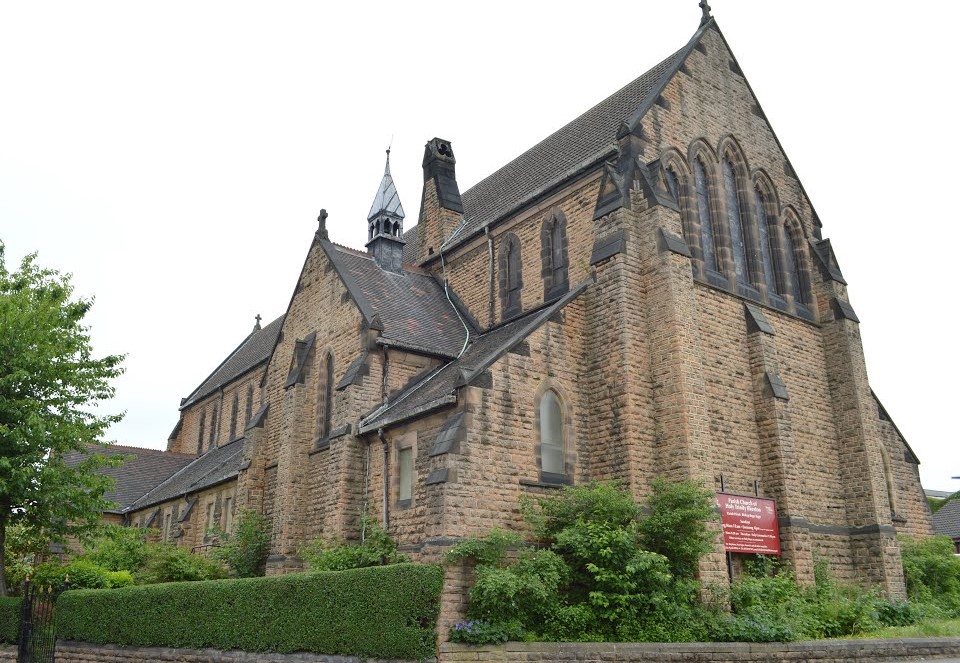
Holy Trinity Church today (achurchnearyou.com)
The debate over the “Romanising” tendency of the Church of England continued well into 1896, and (as is shown elsewhere) was stoked by the presence and work of David Steventon Hyslop. He was pastor of the Church of England Protestant Mission whose ‘calling’ was to oppose and root out such romanising and ritualism in Ilkeston. Thus he opposed the use of candles, crosses, flowers and ‘other signs of Popery’, all supported by the English Church Union. According to David the 4500 clergy of this Union were pledged to do the work of the Reformation and to support Rome. They promulgated the ‘six points of ritualism’ … that is, the east position, altar lights, vestments, the mixed chalice, wafer bread and incense. And at Holy Trinity all six points were in vogue, as David was keen to point out.
The rumble over this issue continued into the next year. At the annual Easter Vestry of Holy Trinity Church it was time to chose the churchwardens. The Vicar reappointed William Ralph Burrows as his appointment. However when it then came to chosing a people’s warden there was an attempt by some to instate a candidate who might be less supportive of the more ritualistic practices of the church. This was heavily defeated although Edwin Trueman once more was given the opportunity to voice his concerns, and his opposition to the church services. All the proceedings were conducted most politely, the speakers showing great respect to each other, with the Vicar fighting his corner admirably while Edwin accepted his defeat gracefully. During the discussion it was pointed out by the Rev. Binney, contrary to what many people had claimed, that the attendance at Holy Trinity had not been injured by the higher ritual in the church — in fact they had had the best congregation numbers in the history of the church after ritual had been introduced into the morning service.
Popular or not, this type of service inflamed passions in some of the congregation. On November 21st 1897, at the culmination of the Rev. Binney’s High Mass service, Arthur Frier Scott of Bath Street, formerly a teacher at the Holy Trinity Sunday School, stood up to announce, unhindered, that he was “a baptised and confirmed member of the Church of England” and was an aggrieved parishioner who hereby solemnly protested against the illegal service he had just witnessed. He added that it was contrary to the Common Book of Prayer and the Thirty-nine Articles. He then walked out.
And now for something completely different: October 1897
Perhaps Ilkeston has the Rev. Binney to thank for the town’s first golf club and course.
The enthusiastic committee of the club, led by its equally enthusiastic secretary, the Rev. Binney, was having trouble securing a suitable site for its links course when they managed to lease a piece of pasture land on the Shipley Estate, large enough for a six-hole course. The turf was ‘good’ and its hedges were used as hazards. I’m afraid I don’t know what the par score was.
————————————————————————————————————————————————————-
Police Report by P.C. Morley: June 27th 1895
I was standing at the corner of Granby Street, at 11pm, when I heard screaming coming from the direction of Holy Trinity Church. On investigation I saw Betsy Straw lying on the footpath, at the corner of Lower Granby Street. Standing over her and kicking her body was her husband, Enoch Straw. When I tried to intervene he struck me on the nose and ripped my tunic as we wrestled to the ground where he kicked me under the left knee. In the melee I lost my whistle and chain.
When I questioned him later, at the police station, the accused — a coalminer at Oakwell Colliery, living in Heanor Road — stated that he had received great provocation from his wife. He said that because it was dark he had not recognised me as a police constable, but thought that I might be a bystander coming to interfere. He said he was sorry !!!
That day Enoch appeared at Ilkeston Petty Sessions and as this was a first offence, for beating his wife he was fined 20s and 17s 6d costs. By that time the couple had had 11 children — they had another four subsequently.
Sunday Trading 1896
Close by the Holy Trinity Church, at 430 Cotmanhay Road, was the hairdressing establishment of Hubert Raynor who also traded in tobacco and sweets. On April 2nd 1896 he found himself at Ilkeston Petty Sessions where he was accused of selling goods on the Sabbath … in other words “doing worldly labour, not being either for necessity or charity”.
On Sunday, March 22nd, the police had noticed several people entering Hubert’s shop, buying tobacco, cigars, and sweets, despite the fact that the shopkeeper had been previously warned that this was illegal. What annoyed Hubert however was that, just a short distance from his premises, were several public houses and a beer-off where the same people could buy those same goods freely and without interference from the police. Giving eveidence in the case, Inspector Savory admitted that no specific complaints had been made about Hubert’s shop but that ‘up and down the town’ complaints had been made about Sunday trading. Though they probably didn’t cite the laws by which they were making these complaints as one of them was over 200 years old !!
In seeking to encourage Sunday worship, the Sunday Observance Act of 1677 and the Lord’s Day Observance Act of 1781 (“An Act for Preventing Certain Abuses and Profanations on the Lord’s Day, Called Sunday” ) together aimed to curb Sunday trading and to prevent the public on such days from visiting parks, museums, zoos, theatres, meeting-houses, and concert halls …. Acts which remained almost unchallenged until the early 1890s. But now Hubert and his legal representative were challenging them. His case was that what was considered unreasonable 200 years ago was now quite reasonable. Ilkeston was a growing town, its inhabitants going for Sunday walks or cycle rides …. and many of them might want to purchase tobacco products. They would sooner go into a shop than into a public house. Hubert had kept his shop for 15 or 16 years and had never had a complaint lodged against him; this was a ridiculous charge with a maximum penalty of only 5s !! The police should be ashamed to bring the matter to court !! In their narrow-mindedness were they trying to drive people from a respectable shop and into public houses. Or perhaps the police should be congratulated ??!! … they had cleared away the whole of crime in the town to devote themselves to this kind of thing !!!
As it soon transpired, Hubert was not convicted and so was not fined — after he had agreed to pay court costs of 9s. The Mayor, who was presiding over the case, hoped that Hubert would keep his shop closed in future, for the sake of the young people and children who might be tempted in, to buy tobacco and cigarettes.
Ten days later Hubert had committed the same offence and once more found himself in the same court before the same magistrates. He argued that other shopkeepers in his area were also open and selling goods without being charged … so he would follow their example. As before he received the same verdict and the same penalty,

